Osteoarthritis
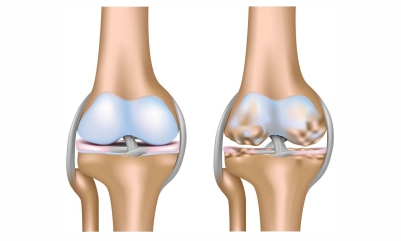
Osteoarthritis is the most common and important type of arthritis. It affects the joint cartilage or articular cartilage (A layer that covers the bone ends and makes the joint movement smooth) of the joints. Osteoarthritis mainly affects the large joints but the most common joint which is affected by osteoarthritis is the knee joint.
When the cartilage layer starts deteriorating, it affects our normal joint movement and disrupts the natural joint function. People experience pain in their joints during joint movement.
If your age is over 45 and you have pain in your knees, then you should be aware of osteoarthritis because it can be a reason for your knee pain.
Stages of osteoarthritis
Basically, osteoarthritis has 2 stages
Early Stage: Early Stage includes
- Grade 1- Doubtful reduction of joint space
- Grade 2- Marked reduction in joint space
- Grade 3- Definite reduction in joint space and visible bone spurs around the joint, at this stage there are slight changes in the normal joint alignment.
Late Stage -Late Stage include
- Grade 4 – Visible extra bone formation and, a marked reduction in joint space, severe malalignment of the joint which causes severe deformity.
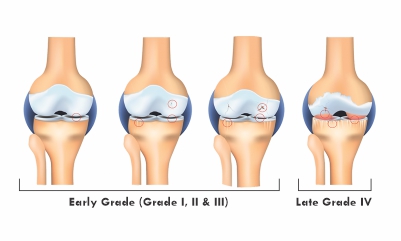
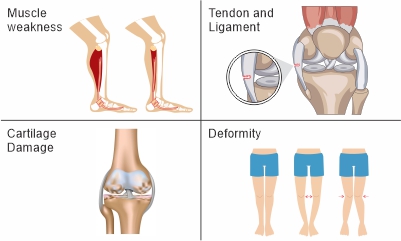
Causes
- Muscle weakness: After the age of 40 our muscle mass reduces 8-10% every year, this muscle weakness exerts an extra load on the joints and causes damage to the joint cartilage.
- Tendon and ligament: Injury to those structures make the joint unstable. Weight transmission axis also affects, and this puts pressure on the joints and leads to further damage.
- Cartilage damage: With age and continuous wear and tear of the joint cartilage leads to cartilage degeneration and damage to the joint. Cartilage degeneration is the root cause of osteoarthritis.
- Deformity: If your joint is deformed due to injury or some other reason, it alters the weight transmission axis and creates uneven pressure on the joint, and leads to osteoarthritis.
Risk factors that cause osteoarthritis are:
- Age: As your age increases your chances of having osteoarthritis also increase.
- Genetics: The gene for osteoarthritis is inherited by the next generation.
- Being obese: This is because there is an increased load on your joints and an increased potential for more joint damage.
- Sex: Women are more likely than men to develop OA
- Occupational overuse of a joint
- Knee injury: The chances of osteoarthritis increase in patients who had sustained a past injury to the knee joint.
- Lack of calcium in the diet: In patients who do not consume a diet containing calcium, the prevalence of osteoarthritis is high.
Symptoms of osteoarthritis:
- Pain
- Stiffness
- Limitation in full joint movement
- Restricted Joint movement
- Creaking, clicking, or popping noises when the joint moves
Diagnosis of osteoarthritis
During the physical examination, experts commonly check for swelling, tenderness, and flexibility.
Imaging tests
- X-rays: First and basic screening is done by X-ray. The X-ray can show the joint space and bone spurs.
- Magnetic resonance imaging (MRI): MRI can be done to check if there is any soft tissue damage or other structural damage.
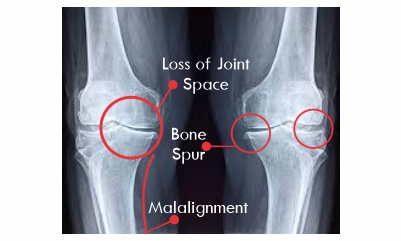
Treatment
- Conservative Treatment:
- Drugs: Drugs used to treat OA include – Nonsteroidal anti-inflammatory drugs (NSAIDs), Painkillers like Ibuprofen/ Paracetamol, etc.
- Physiotherapy Exercise: Strengthening Exercise, Flexibility Exercise, Exercises to improve the range of motion of the joint.
- Physiotherapy modalities: Heating Modalities, TENS, Muscle Stimulator, etc.
- Regenerative Medicine: An ideal treatment for early grade osteoarthritis (Grade 1, Grade 2, and Grade 3 OA): Early grade of osteoarthritis can be delayed or reversed by regeneration and rehabilitation.
-
Adipose Derived tissue/ cellular fraction: It is a novel regenerative treatment that is able to treat the root cause of osteoarthritis. Experts believe that it offers a biological solution to the biological problem and early intervention can help arrest the progression of Osteoarthritis.
- Simple Effective Method: Level I evidence present. It is done in same surgical sitting under local anesthesia. No chemical, animal products, or enzymes have been used. No need for a change in lifestyle. Patients can walk back home the next day. No risk of infection, allergic reaction, and rejection.
- How this is done?
- In this procedure, around 200 ml of fat is taken out from the abdomen within 40 min without using any type of enzyme, chemical, culture, or animal product. Cellular fraction in derived by technology, which is injected into the affected joint.
- Till now, thousands of patients have been treated in India and around the world. It offers a minimally invasive solution for patients suffering from Knee pain due to early osteoarthritis.
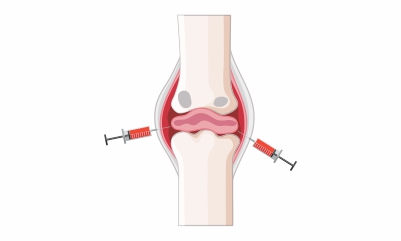
- PRP (Platelet Rich Plasma): PRP is acellular, i.e. it does not have any regenerative cell but has growth factor and cytokines which helps in reducing pain. It is found in different studies that it has short term effects that may last from few days to few months
- ACI (Autologous Chondron Implant): This technique is only suitable for treatment of Chondral lesions not for Osteoarthritis. This surgery is done in multiple surgical sitting which involves healthy cartilage piece withdrawal from patient joint, then it is send for culture in lab at remote place which generally take 21-25 days, then in second surgical sitting cultured cells along with fibrin glue are placed in open surgery or through arthroscopy at the effected or torn lesion of cartilage. After these multiple sitting to achieve complete weight bearing required around 5 to 6 weeks of time.
Note: This treatment is only for Chondral lesions not for Osteoarthritis or patient having multiple lesions - Bone Marrow Aspirate Concentrate (BMAC): In the past, BMAC was used. It is a component of bone marrow.The possible disadvantages of using BMAC are that the cells are present only in the first 3-4 ml of bone marrow. The number of cells derived is less as compared to adipose-derived tissue SVF. Cells are cultured i.e. enzymes are used. Rates of infection are also quite high.Other complications of the BMAC include increased pain, bleeding, and nerve damage.
-
- Surgery
- Joint Preservation Surgery like osteotomy:
- Proximal Fibular Osteotomy (PFO)
- High tibial Osteotomy (HTO)
- SupraCondylar Osteotomy (SCO)
- Joint Replacement Surgery: When all the medical means to treat the pain of arthritis fail, then total knee replacement is the last option available.
Recommended in the late grade of osteoarthritis i.e. Grade 4 with severe deformity or people with an insatiable joint and patient age is more than 65.- Complications of joint replacement:
- Highly invasive
- Restricted lifestyle
- Risk of infection
- Limited flexibility
- Damage to the surrounding structures
- Implant rejection
- Complications of joint replacement:
- Joint Preservation Surgery like osteotomy:
